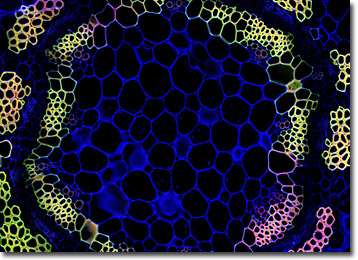 |
 |
 |
|
||||||||||||||||||||||||
 | ||||||||||||||||||||||||
 | ||||||||||||||||||||||||
 | ||||||||||||||||||||||||
Confocal Microscopy Image Gallery
Plant Tissue Autofluorescence Gallery
Cactus Stem
The cactus is one of the most recognizable plants native to the Americas. The thick, fleshy stems of cacti rarely exhibit leaves and instead typically bear numerous prominent spines that offer them protection from a wide range of animals. Most cacti thrive in the desert, where several adaptations enable them to acquire and retain as much water as possible.

The shallow root system characteristic of cacti allows enhanced uptake of water following the gentle rain showers that sometimes occur in the arid habitats they commonly populate. Also, without leaves, cacti lose a much smaller amount of water via transpiration than do most other plants. A tough layer of tissue surrounding the stems of cacti and special substances within the storage cells located inside the stems further reduce loss of water.
Cacti are dicots that are classified as belonging to the family Cactaceae. More than 1,500 species of the plants have been identified, and there is significant variation in their size and shape. Prickly pears, for instance, exhibit flat, pad-like stems, whereas the well-known symbol of the American southwest, the saguaro, has a tall, columnar stem, usually with several sizable branches that curve upward. The flowers produced by cacti are typically large and solitary, but vary in appearance similar to cacti stems. Red, white, yellow, and purple are some of the most common colors cactus blooms display. The delicate flowers of the cactus are very sensitive to light and usually blossom for a very short period of time. A species popularly known as the night-blooming cereus is particularly distinguished for its fragrant flowers that only blossom for a single night, an event that is marked with festivities in some regions.
Contributing Authors
Nathan S. Claxton, Shannon H. Neaves, and Michael W. Davidson - National High Magnetic Field Laboratory, 1800 East Paul Dirac Dr., The Florida State University, Tallahassee, Florida, 32310.
